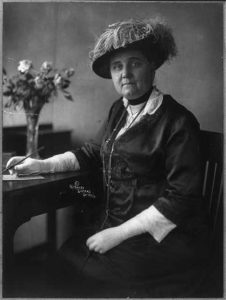
Jane Addams
1860-1935
Jane Addams was born in northern Illinois to a prosperous midwestern family. Her father, John Addams, was a successful businessman and also served as an Illinois State Senator. Her mother passed away when she was two years old. At age four, she contacted Pott’s Disease, or tuberculosis of the spine, which left her with a limp, a curvature in her spine, and lifelong health issues. Addams graduated from Rockford Female Seminary, in Rockford, Illinois, in 1881. Her father passed away a few months later, and in the fall she moved to Philadelphia to attend the Women’s Medical College of Pennsylvania, but health issues and a nervous breakdown prevented her from graduating. After two years in Pennsylvania she moved back to Illinois, where her brother-in-law performed surgery to straighten her spine. Following this, she travelled to Europe on her brother-in-law’s advice. After returning to Illinois in 1887, she began to write letters to a friend from Rockford Seminary, Ellen Gates Starr, and a relationship developed.
During this time, she read books on religion and on women from authors like Tolstoy and John Stuart Mill. In a magazine, she read an article about settlement houses, and decided to visit the world’s first, Toynbee Hall in London. Addams, Starr, and a group of friends, travelled Europe during late 1887 and early 1888. After revealing to Starr her desire to start her own settlement house, Starr agreed with the idea. In 1889 the pair opened Hull House in a run-down mansion in Chicago, built by Charles Hull in 1856 and located in the majority-immigrant West Side neighborhood. Addams paid for the repairs, and she and Starr were the first two residents. At any one time, the House was the residence of about 25 women. Hull House became a center for research, study, and a center for relations with the surrounding neighborhood. Its facilities included a night school, a public kitchen, an art gallery, a gym, a theater, a library, an employment bureau, apartments, a lunchroom, and more. At its peak, Hull House was a 13 building complex, and included a playground and an off-site summer camp known as the Bowen Country Club.
In her focus on children and childhood at Hull House, Addams organized the creation of kindergarten classes, boys’ and girls’ clubs, reading groups, and a gym in addition to the playground and summer camp. Classes in art and drama were also offered, as well as language classes for the children of immigrants. In 1901, Addams and other Hull House leaders established the Juvenile Protection Association. This Chicago-based non-profit, still in operation today, provided probation officers for the nation’s first Juvenile Court, as well as engaging in studies on child labor and other issues.
Over the course of her life, Jane Addams constantly fought against the child labor she saw in her own Chicago and around the nation. She frequently travelled to various cities around the United States to deliver speeches at different events and conferences, some of which are analyzed here. An intimate relationship between Jane Addams and Mary Rozet Smith that would last almost 30 years formed during this time, and there is evidence that they viewed themselves as a married couple. In 1931 she became the first American woman to win the Nobel Peace Prize. Jane Addams passed away in 1935.
In 2007, the State of Illinois declared December 10 as Jane Addams Day, and dedicated the Northwest Tollway, a 76-mile section of Interstate 90, as the Jane Addams Memorial Tollway. A majority of the Hull House complex, as well as the surrounding neighborhood, was demolished in 1963 for the construction of the University of Illinois at Chicago (UIC). The Hull House residence building, however, was relocated and operates today as a museum on the university’s campus, and the UIC College of Social Work is named after Jane Addams.